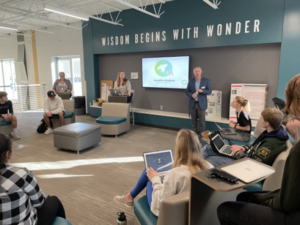Learning a la carte (and how to make it coherent)
Rick Hess has laid out a market-friendly education agenda at American Enterprise Institute, something I appreciate, and recently hosted a form on the demand side of quality education. I participated on a panel; everyone else wrote a paper; I got off easy as ‘discussant’.
Kim Smith, founder of New Schools, outlined strategies for building responsive supply including getting smarter about market segmentation and starting by placing students and families at center of attention. Kim outlined how diverse supply will benefit educators with a variety of employment options. She concluded with trends in personalization combined with what Fred Wilson would call an unbundling of services–kids will increasingly be able to build a learning transcript from a variety of providers.
Eric Osberg, Fordham, co-authored a paper with Checker Finn and echoed this a la carte theme of choice within as well as between schools (of course, they’d like to see it all be variations of Core Knowledge).
On exploding choices within schools—a digital café of learning—it reminds me of the insidious tracking created in the 70s with the advent of giant high schools and a college size course catalog. Well supported and motivated students were able to string together a college-ready sequence, while less well supported and motivated students were guided into remedial and vocational courses just sufficient to graduate. An explosion of choice is great if guided by a common goal of ensuring that all students graduate from high school with viable life options.
With personalization to the learning object level—a customized path to mastery—it will be well beyond the ability of a counselor or advisor to recommend and track a student’s learning experiences. A smart learner profile and recommendation engine (that over the next 10 years will approach a form of artificial intelligence) will guide the student experience considering not only level, but best learning modality, motivational preferences, current interests, as well as popularity and performance of a particular learning experience with other students. The smart profile will inform conversations between the student and his/her advisor and teachers and, over time, may replace seat time and credits as the primary mechanism of matriculation (a digital merit badge with accompanying portfolio).







0 Comments
Leave a Comment
Your email address will not be published. All fields are required.